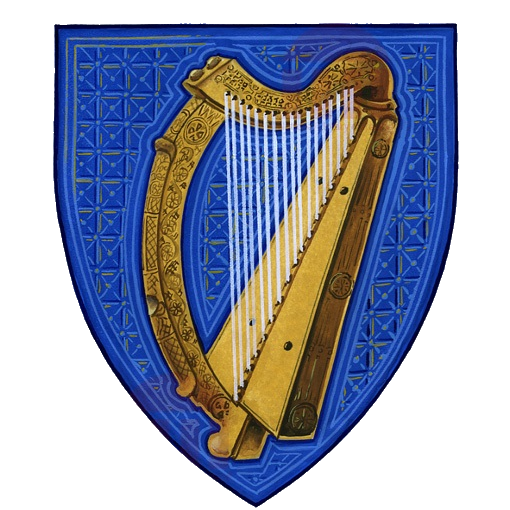Moybolgue Family Name
By Philip Donnelly, Ottawa, Canada
The old cemetery of Moybolgue, about three miles south from the town of Bailieborough, on the border between Meath and Cavan, is of great historic interest. It is reputed to be the burial place of more of the ancient Irish kings than anywhere else in Ireland[2]. A history of the Roman Catholic part of the parish around the village of Kilmainhamwood has already been recorded[3]. But the heritage and legends of the civil parish known as Moybolgue and the stories of the people who lived there are yet to be told.

Moybolgue old cemetery
A history of Moybolgue should preserve some valuable memories of the ordinary people who, for thousands of years, cultivated the soil, harvested the turf, and tended the cattle, on the hills and in the valleys of this region. The traces of ringforts and crannogs (dwellings in lakes, supported on wooden posts) which dot the landscape, but which may be recognizable only to trained archaeologists, give some clues about the people who lived here in the Early Christian periods and into the Middle Ages[4]. But too much time and too many generations have slipped by in the intervening centuries, and even the most tenuous links to that distant past may have vanished for ever. The passing of just 150 years has gone a very long way towards wiping out all living recollections of the 386 families who populated the surrounding townlands and were the tenants or owners of land in the civil parish of Moybolgue in 1854[5].
In the County Cavan part of the parish, there were about 185 families, including some landlord names, in the townlands of Aghnaclue, Ballynamona, Blackhills Lower & Upper, Carnans Lower & Upper, Greaghnadarragh, Leitrim, Relaghbeg, Relaghmore, Srahan, and Tullynaskeagh.
The names, in descending frequency of occurrence, were Clarke, Donnelly, Reilly, Cooney, Tully, Farrelly, Coyle, Garigan, Brady, Haig, Daly, Gaffney, Smith, Bowen, Caffrey, Crossan, Donnellan, Farnan, Flanagan, Gellan, Gill, Heery, Matthews, McCabe, Olwill, Sheridan, Blacker, Bowen, Carolan, Chambers, Clinton, Connell, Cox, Cullen, Curran, Cusack, Dailly, Dunne, Fitzsimons, Flack, Fottrell, Fox, Gallagher, Gillan, Gilston, Gonne, Gumly, Halfpenny, Heeny, Lanesborough, Machonchy, Magawelly, Maguire, McCann, McDermott, Mitchell, Murray, O’Hare, Parr, Pidgeon, Rogers, Smyth, Sullivan, Tierney, Young.
That part of the parish situated in County Meath is composed of the townlands of Agheragh, Bawnbreakey, Boggan, Corcarra, Corgreagh or Killagriff, Cormeen, Doon, Drumbulrisk, Drumlayne, Kilboyne, Kilfannan, Letachmentgallon, Lisnaboy, Losset, Moyhill, Mullaghavally, Mullystaghan, Teevurcher (Tierworker), Tirachorka (Tiercork), and Tirawinnea. A total of 201 families, including some landlord names, were represented in these townlands.
The names, in descending frequency of occurrence, were Clarke, Gargan, McEntee, Smith, McCabe, Williamson, Curran, Reilly, Carolan, Farrell, Fitzsimons, Ormanstin, Cahill, Fleming, Rogers, Tully, Blake, Cassidy, Daly, Fay, Gordan, Miles, Pringle, Roundtree, Brady, Clinton, Connell, Connolly, Cox, Donnelly, Farnan, Gaffney, Hart, Lynch (Rev.), Mawhertor, McDermott, Mitchel, Murray, Westenra (Col.), Anderson, Barrett, Bellew, Bligh, Brien, Brown, Browne, Carry, Conniety (Rev.), Crawford, Fallon, Farley, Finegan, Finley, Garigan, Gaynor, Gleany, Halpin, Halton, Hand, Hynes, Keane, Kernan, Marry, Martin, Mathews, McMahon, McMohon, McWherter, Mooney (Rev.), Mullen, Pollock, Shaffry, Snow, Sullivan, Walsh, Waters, Winright.
The United States, Africa, Australia, England and Scotland may have captured the lions share of the descendants of these families, but it is a sure bet that there are children on every continent who have no idea that their great-great-great-grandparent lived within sight of the motte of Moybolgue, and their mortal remains rest in the shadow of the stone wall ruins still standing after all those years at the centre of the ancient graveyard.
Those Canaan days we used to know
Where have they gone, where did they go?
Eh bien, raise your berets
To those Canaan days[6].
[1]A version of this article appeared in the April 3, 2003 edition of The Anglo-Celt, a weekly newspaper published in the town of Cavan, Ireland
[2] Bailieboro Historic Sketch by J. A. Coleman, The Bailieboro Studio (1914)
[3] Kilmainham of the Woody Hollow, Danny Cusack, Kilmainhamwood Parish Council, Kilmainhamwood, Co. Meath. (1998)
[4] The Irish Ringfort, Matthew Stout, Four Courts Press (1997)
[5] Griffith’s Valuation of Ireland, 1848-1864
[6] Andrew Lloyd Webber musical – “Joseph and the Amazing Technicolor Dreamcoat”

